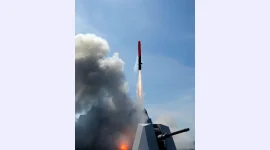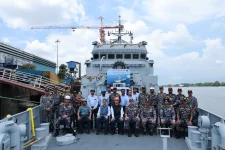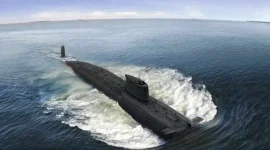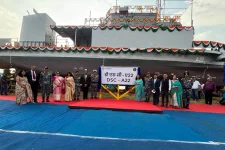Boss, I am not saying we should just put our AShMs on inclined launchers. To start with, that is not a feasible solution since the BrahMos is considerably larger than a Tomahawk or a Harpoon or an Exocet, etc. For those, we need VLS.
I am also not saying we follow the example of South Korea or Japan and just stuff the ships with a few hundred missiles. That is just inviting massive attacks, and quite possibly, a catastrophic magazine explosion and sudden crisis of existence.
However, the fact also remains that these destroyers are the largest surface warships that aren't carriers, and may quite possibly be operating independently or in a small group. The Houthis have shown they can fire literally hundreds of missiles at ships.
Let's assume China decides to engage a small group of our ships. They can very well end up launching a couple of hundred cruise missiles (long range subsonic ones, mind you, which are also comparatively cheap). Do you think our ships would survive that, if they can only put up 32 SAMs apiece and use their AK-630s for around 100 seconds each?
These large surface warships would be priority targets in times of war. As such, while stuffing them full of missiles isn't a good idea, there also needs to be a credible minimum level of defensive equipment, which isn't necessarily true for now.
As for where you would put these 32 or 48 additional VLS cells for SAMs, well, there is plenty of deck space available. With some internal rearrangement and external bulwark, you can get enough space for VLS cells. Alternatively, we could also look at some new type of VLS cell that may perhaps allow for using the BrahMos / ITCM (both will be compatible to be fired from a single cell) and also allow for multi-packing of SAMs. That'd allow you a lot of flexibility.
Oh, and why exactly we continue to use the RBU-6000 on frontline warships is a matter of debate. Even with the 8.9 km ranged anti-torpedo rockets of the system, you aren't engaging a submarine, and the chances of successfully intercepting torpedoes with these unguided rockets is quite small. Just removing that system could allow for atleast 24 VLS cells just on that platform with an external bulwark. Of course, the RBU-6000s could be retained on the mid-sized frigates, ASW corvettes, etc. The problem is that this system takes up too much space for what it's worth.
Answered in corresponding paragraphs pattern ---
Kashin & P-15 DDGs have deck-based Brahmos slant-launchers. It is "doable".
No Navy overstuffs their vessels -- South Korea or Japan. It is a misconception. RoKN & JMSDF have more VLS because they've Aegis (Ashore + Ship) and lacks terrestrial space to mount an effective networked BMD and AD. CIC, VLS, power gen & power distribution compartments are armoured w.r.t. rest of ship.
Indian DDGs have
CEC. DDGs & FFGs and others operate in networked & formation - any country (unless your're outcast) anywhere they operate -- even during Prosperity Guardian. Houthis can fire any number of missiles, they're no threat to any warship, but a nuisance. French used NH-90 to shoot down a Houthi ASHM. Italian shot another down with SRGM. That's how they are lame.
If assumption is the name of the game, then let's soar higher. Where does China decides to engage a small group of "our" ships -- IOR or SCS
? China engaging Indian ships is an ACT OF WAR. Then they face Brahmos. Let's also assume that French & American naval forces come to our rescue from Reunion & Diego Garcia.
What is your estimate as to why Navy chose what they chose credible minimum level of defensive equipment
? Indian Navy is the only dominant navy in IOR with CEC & OTHT capability w.r.t. Brahmos.
An 8-cell empty Brahmos VLS is called
3S-14UE1 UKSK with
~10 m and width of
2.3m. Check internal schematics of any decommissioned older ships -- Try Americans, Russian & French and their VLS. Focus especially on the underdeck vents, pipings, electricals & hydraulics, pedestals, vibration isolation mountings, fire extinguishing, maintenance hatches, hazard monitoring sensors. A picture is worth thousand words. Find out through estimation/observation whether BrahMos/ITCM will have same VLS length & dia.
In ASW domain, RBU-6000 does
4 things -- destroy the torpedo, disrupt the route, snap the wire-guidance, haywire the transducer due to explosion. They are effective in destroying torpedo -- that's why they 're on every ship. It's a
sasta-tikau 212 mm aquatic mortar. In Indian ship, RBU-6000 is part of IAC MOD ‘C’ suite. You want extra AD air cover at the expense of ASW? How would your ship, working "independently" as you've mentioned, defend against a multiple HWTs fired by SSN ? How did you arrive at 24 VLS figure?
Why are you so VLS-centric? What do you want more inside a VLS --- LACM, AShM, SAM or ASW
??
What is your estimate of "adequate" no. of VLS
? If 32 is underarmed, there may arise a pitched scenario where 48 is also deficient
?
What threatens a ship
more - AShM or Torpedo
?




